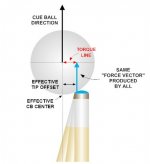Saying the CB "feels" one force is a shorthand way of saying it "reacts as if there's" one force.
On a side note, you say there are two forces as I do, but your second force is a force through the CB's center (like when two balls collide) whereas mine is squirt. I don't believe the force through the CB's center is significant unless there's little to no friction between the objects (as in ball/ball contact). But conversely, with tip/ball contact there's little to no slippage between the objects - I think this virtually eliminates that "carom" force.
pj
chgo
The force from cue tip contact point through ccb is always there because the cue stick always has mass.
Regardless of the friction (or lack of friction) between the ball and the tip, a force is exerted from point of contact through the ball's center of mass. It's the normal force. The chalked cue tip ensures a friction force counters this normal directional force. Naturally if there were little to no friction at the contact point, the resulting cb path would go very near the same direction as the normal force, like when two balls collide. But with a chalked leather tip, having very little to no slippage, the force exerted from the mass of the cue moving along the stroke line is prevalent.
If the cue shaft has no tip and absolutely no flexibility, the full weight of the cue stick will force the cb out of the way and onto a path somewhere between this normal force (contact point to ccb) and the stroke path of the cue stick, depending on the weight of the stick. If this non-flexible cue stick weighed 6oz, the cb path would follow the path of this normal force, as if struck by another ball.
Fortunately we play pool with flexible shafts and leather tips. And we don't have to consider too much of this force business, as long as we understand what the cb does when struck with our specific cue. So if players use a touch of inside and make it work, so be it.
Last edited:
